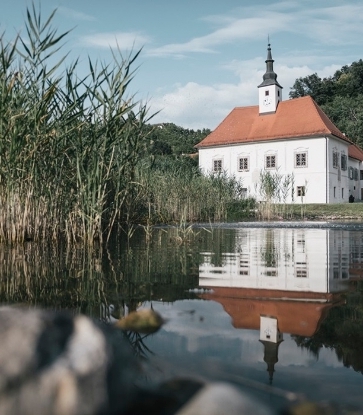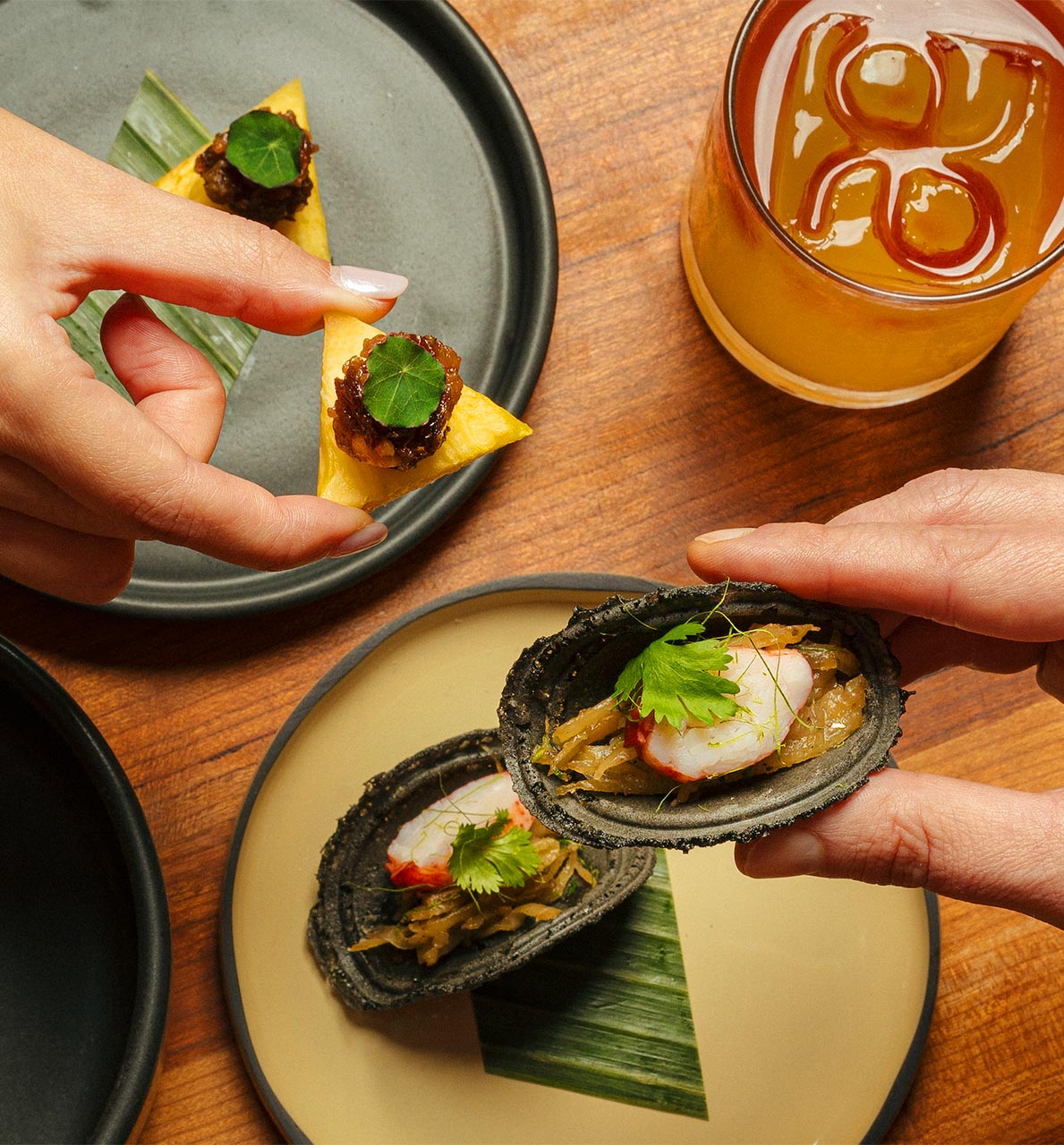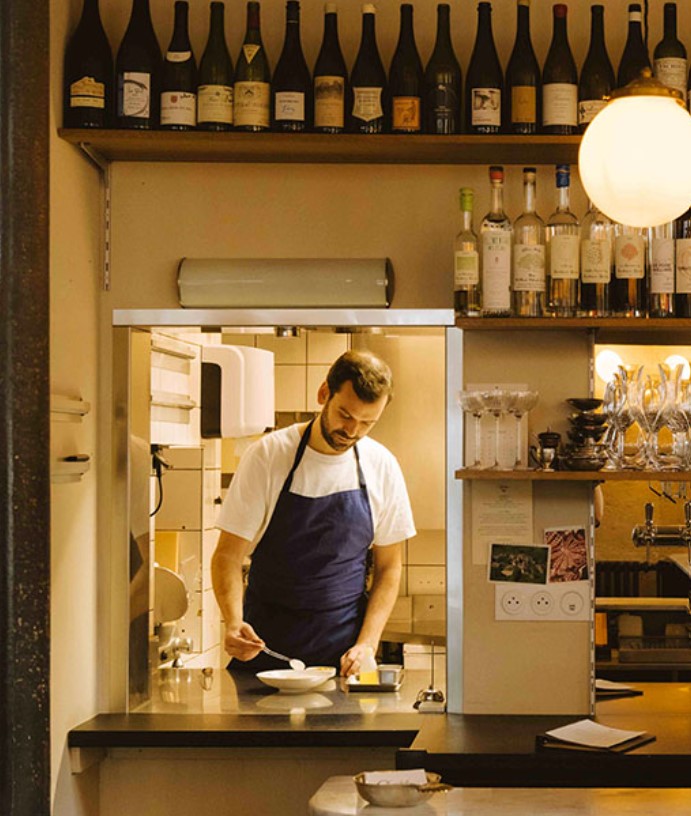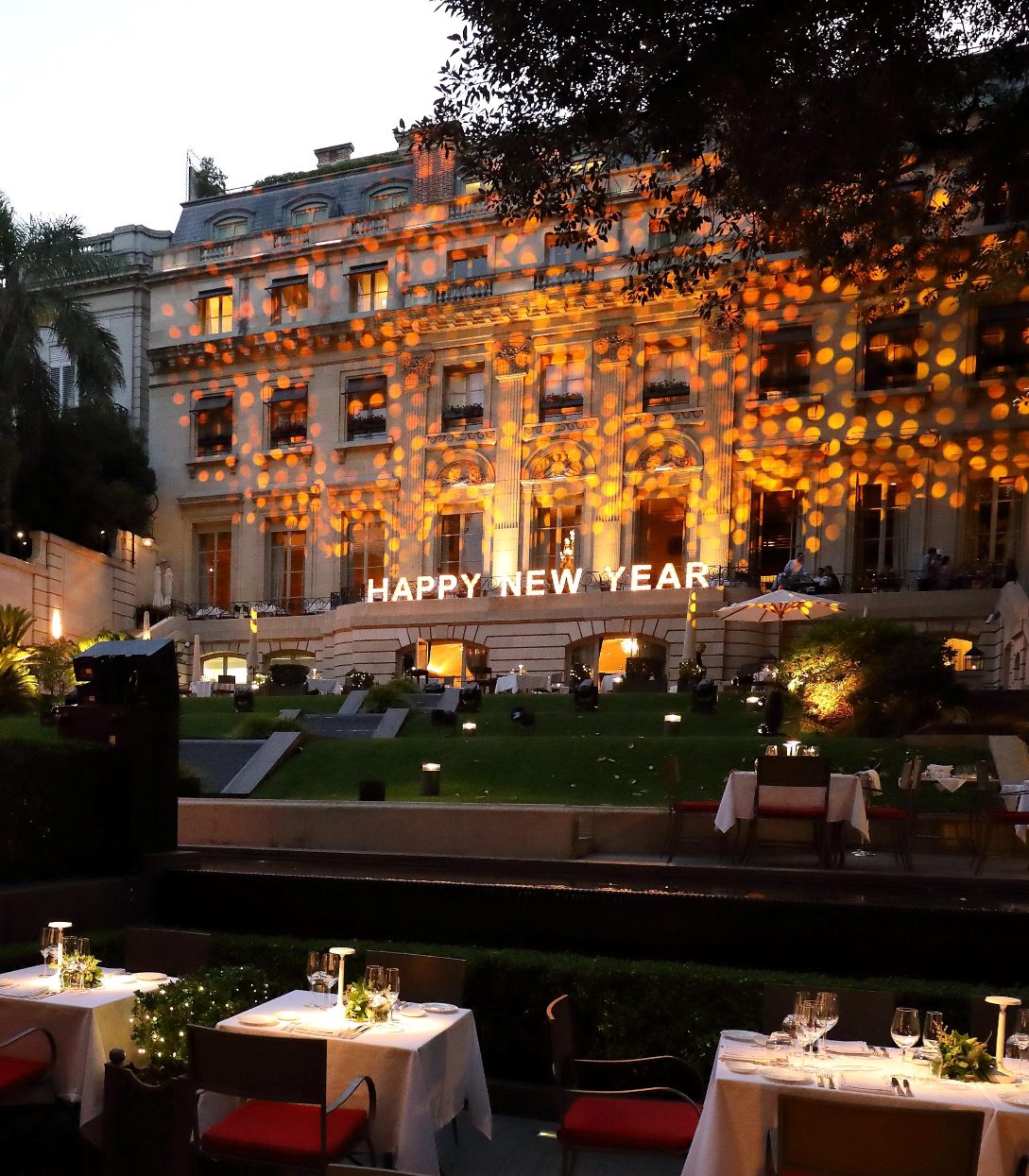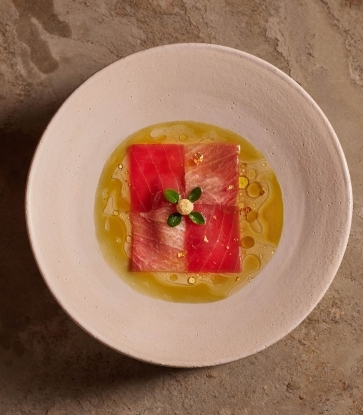1. Parasite (2019) + Yurimmyeon restaurant in Seoul, South Korea

Palme d’Or Winner | Vibe: Ram-don with a side of social commentary
Instant noodles and premium beef never looked so devastating and class warfare has never been so slurpable.
Where to dine: Yurimmyeon in Seoul (a MICHELIN Guide Bib Gourmand)
At this family-run eatery that’s been around for over 50 years, go for the bowls of buckwheat noodles made from scratch, and stay for the comforting nourishment. Topped with seasoned vegetables, thin strips of egg garnish, and a dollop of sweet and spicy sauce, a bowl of these noodles makes for a satisfying meal. Garak-guksu, wheat noodles in piping hot broth, comes with a generous serving of fishcake. It’s the perfect reminder that healthy family bonds do exist.
2. La Dolce Vita (1960) + Aroma restaurant in Rome, Italy

Palme d’Or Winner | Vibe: Aperitifs, late-night oysters, and existential hangovers
Fellini’s Roman masterpiece is less about what’s on the plate and more about what’s in the glass — and who’s kissing whom over it. Dining here isn’t sustenance. It’s theater.
Where to dine: Aroma in Rome (One MICHELIN Star)
Refined, sultry, and a touch surreal with one of the best views of the Colosseum — this is where Marcello might have gone for dinner after the Trevi Fountain, preferably still soaking wet and smoking. Order something flamboyant and contemplate your life choices while the sun sets behind the Colosseum.
3. Babette’s Feast (1987) + Kadeau restaurant in Copenhagen, Denmark

Jury Prize | Vibe: Spiritual awakening one meal at a time
One woman, one feast, infinite grace. If gratitude had a flavor, this would be it. Austere Danish villagers receive an unexpected gift in the form of a lavish French dinner, and by the time the turtle soup arrives, they’ve achieved emotional enlightenment — give or take a sherry. It’s less a meal than a symphony of grace, gratitude and perfectly poached quail.
Where to dine: Kadeau in Copenhagen (Two MICHELIN Stars and a Green Star)
A truly stunning restaurant, Kadeau offers detailed, precise craft in every bite. In particular, it is an ode to the ingredients of Bornholm, from where the owner hails. The kitchen team take this produce and work their magic with a multitude of techniques, from pickling and preserving to drying and curing. The result is a knockout meal that Babette herself would be proud of. In fact, it's the kind of thing she might have cooked if she'd swapped Paris for New Nordic minimalism.
4. The Lunchbox (2013) + Jamavar restaurant in London, UK

Critics' Week Viewer’s Choice | Vibe: Romance by way of a steel tiffin container
Turning a tiffin box into an emotional lifeline, while earning bonus points for making lentils seem heartbreakingly romantic, The Lunchbox details how a mistaken lunch delivery becomes an accidental love letter in edible form. It’s a slow-burn romance steeped in Mumbai spice, handwritten notes, and quietly transformative home-cooked meals. You’ll never look at dal the same way again.
Where to dine: Jamavar in London (One MICHELIN Star)
An upscale Indian restaurant where tradition simmers under silver service. Instead of traditional starters, there’s an extensive selection of small plates to share — think succulent narangi prawns and soft, smoky kebabs that feel like edible affection. For main courses, hot tandoor dishes shine, especially the stone bass tikka, while the gucchi lababdar is a must-order for mushroom lovers. For the full journey (and maximum emotional resonance), go for the tasting menu. This is where precision meets heart — just like Ila’s cooking.
5. Ilo Ilo (2013) + The Coconut Club, Singapore

Camera d’Or, Cannes | Vibe: Noodles, nostalgia, and the taste of quiet devotion
Set in late-90s Singapore, Ilo Ilo tenderly captures the unspoken tensions and tender connections between a middle-class family and their newly arrived Filipino maid, Teresa. It’s a film of modest gestures and big emotions — where love is ladled out quietly in bowls of rice or noodles and reprimands laced with concern. Domestic life has rarely felt so raw, or so richly observed.
Where to dine: The Coconut Club – Singapore (a MICHELIN Guide Bib Gourmand)
Lots of Instagram-friendly corners here. The dish here might not appear in the film, but it captures its spirit: a coming together of cultures, humble and heartfelt. Nasi lemak — rice steamed in coconut milk, served with fried chicken and a jammy egg — sits comfortably beside the Filipino silog breakfast of garlicky rice, pickled atchara, and something savory on the side. Both are working-class comforts, wrapped in love and labor.
6. Princess Mononoke (1997) + Miyamaso restaurant in Kyoto, Japan

Cannes Legacy | Vibe: Moss, spirits, and slow-simmered moral ambiguity
Nature fights back — beautifully. Hayao Miyazaki’s Princess Mononoke is a sweeping eco-epic set in a mythical forest where gods roam, boars rage, and every tree breathes. It’s a story of industry versus instinct, told in brushstrokes and battle cries. Studio Ghibli, the animation house behind Miyazaki’s work, was awarded an honorary Palme d’Or — a fitting tribute to decades of hand-drawn magic. This is a film that lingers like woodsmoke on your coat — contemplative, wild, and filled with grace.
Where to dine: Miyamaso in Kyoto (Two MICHELIN Stars and a Green Star)
Dining here feels like stepping into the spirit realm. Nestled in Kyoto’s mist-shrouded mountains, Miyamaso is a ryokan where the chef forages the surrounding forests each day — returning with wild herbs, river fish, and seasonal treasures that whisper of the land. Each dish is a quiet ode to nature, plated with reverence and restraint. You don’t eat so much as commune. The thatched-roof setting, the wooden beams, the breeze through the trees — it’s less a meal than a meditation. And in a world that moves too fast, Miyamaso reminds you to slow down, breathe deep, and listen.
7. Blue Is the Warmest Colour (2013) + Restaurant des Grands Boulevards Experimental, Paris, France

Palme d’Or Winner | Vibe: spaghetti, shellfish, and the taste of first love
Coming-of-age never looked — or felt—so ravenous. Adèle eats, loves, cries, and eats again in this intimately sprawling film that dares to believe meals can be just as revealing as kisses. (Also: spaghetti never looked so emotionally loaded.)
Where to dine: Restaurant des Grands Boulevards Experimental in Paris (in our MICHELIN Guide selection)
While the film was set in Northern France, this spot in Paris headed up by Chef Giovanni Passerini is a great match. It’s young, buzzy, and defiantly nonchalant; this is the kind of place where you’ll spot guests with cerulean hair and complicated feelings, all while diving into good seafood linguine. The vibe is inclusive, stylish, and slightly chaotic in the best way — perfect for lingering conversations, heartbreak post-mortems, and maybe even falling in love over shellfish. It’s not a film set, but it might as well be.
8. The Taste of Things (2023) + Pierre Gagnaire restaurant in Paris, France

Best Director, Cannes | Vibe: Truffled chicken, flaky pastry, and edible seduction
A love story cooked low and slow. Juliette Binoche stars as a quietly brilliant cook entangled with her gourmet employer in a turn-of-the-century kitchen where every glance is garnished and every dish says what words can’t. It’s a romance told through veal, pears, and a vol-au-vent that might make you weep.
Where to dine: Pierre Gagnaire in Paris (Three MICHELIN Stars)
The film’s culinary soul was born here. Chef Pierre Gagnaire advised on every dish, from the glistening poached chicken with truffles to a pear dessert topped with a wafer-thin fripé that flutters like emotion itself. It’s haute cuisine as heartbreak: poetic, theatrical, and just the right amount of unhinged. You’ll leave wondering if your main course is gazing back at you with love.
9. Lost in Translation (2003) + Narisawa restaurant in Tokyo, Japan

Best Screenplay, Cannes | Vibe: Whisky, silence, and late-night ramen
Loneliness has never looked so chic. Sofia Coppola’s jet-lagged dreamscape follows two strangers adrift in Tokyo’s neon glow — finding fleeting connection in hotel bars, karaoke booths, and the city’s quiet in-between spaces. It’s melancholic, minimal, and deeply human — like a haiku written in neon.
Where to dine: Narisawa in Tokyo (Two MICHELIN Stars)
Chef Yoshihiro Narisawa channels Japan’s satoyama — the rural landscapes where humans live in harmony with nature — into an experience that’s quietly profound. His “innovative satoyama cuisine” draws on traditional crafts like lacquerware and washi paper, creating a meal that feels meditative, seasonal, and deeply respectful of place. Much like the film, dining here is about finding connection in quiet, beautifully composed moments. You’ll leave full, but also a little lighter on your feet — as if the world makes slightly more sense.
10. Pulp Fiction (1994) + Langer’s Delicatessen in Los Angeles, US

Palme d’Or Winner | Vibe: Pastrami, profanity, and philosophical debates over breakfast
Tarantino’s genre-bending fever dream made us all question what’s in a briefcase — and what a burger tastes like in France. Between hit jobs and pop culture monologues, Pulp Fiction is a love letter to diners, early breakfasts, late-night cravings, and the kind of booth-side banter that belongs in a museum.
Where to dine: Langer’s Delicatessen in Los Angeles (a MICHELIN Guide Bib Gourmand)
Sure, Jules and Vincent might’ve preferred pancakes with a side of bacon after a hit, but if they knew better, they’d be posted up in a vinyl booth at Langer’s. It’s got pure, unapologetic Americana with a cinematic swagger. Since 1947, this MacArthur Park institution has been dishing out latkes, blintzes, and the kind of hot pastrami sandwich that demands full attention. Bonus points for finishing with a slab of rich cheesecake — because nothing says “redemption arc” like dairy and carbs.
11. Chocolat (2000) + La Cuisine de la Fontaignotte restaurant in Burgundy, France

In Competition, Cannes | Vibe: Cacao, temptation, and edible acts of rebellion
When Juliette Binoche breezes into a sleepy, God-fearing French village and opens a chocolate shop during Lent, the locals are scandalized — and, soon enough, sweetly seduced. Chocolat is part fairy tale, part food manifesto, filmed in the medieval village of Flavigny-sur-Ozerain in Burgundy, where time seems to melt more slowly than a square of dark Valrhona.
Where to dine: La Cuisine de la Fontaignotte in Flavigny-sur-Ozerain (in our MICHELIN Guide selection)
A mere truffle’s toss from the film’s cobbled streets, this 17th-century townhouse restaurant is perched above the Armançon River, offering views so romantic they feel scripted. But the real revelation is in the kitchen. Chef Martin Vial’s fresh, vibrant dishes — like smoked trout kissed with vine shoots and beetroot baked in a salt crust — are anything but nostalgic. He sources from local farmers across Auxois and Burgundy, crafting plates that feel both rooted and revelatory. It’s the sort of place Vianne might’ve gone after closing up her shop, trading truffles for trout and a view to stir the soul.
And the winner is…

The Taste of Things + Pierre Gagnaire
Why the pairing wins:
This is the full dégustation of a pairing. A Cannes Best Director win. Juliette Binoche. A film soaked in truffled longing and turn-of-the-century terroir. It’s as if Babette’s Feast and Call Me by Your Name had a French culinary baby. The food is the plot, the romance is the seasoning, and the emotional stakes are cooked sous-vide in cream and despair.
Now enter Pierre Gagnaire, a titan of French cuisine, whose very own kitchen advised the film and helped choreograph its most sensual scenes (yes, there’s a pear tart moment that could win an Oscar). This is a restaurant where foie gras and philosophy share a plate, and where a flaky vol-au-vent is as emotionally devastating as any breakup scene. You’re not just tasting France — you’re eating the mise-en-scène.
Runner-up:
Babette’s Feast + Kadeau (Copenhagen), for sheer emotional gravitas and Nordic theatricality. But it doesn’t have Binoche. Or a cameo by Pierre Gagnaire as a pretentious rival chef.
Hero Image: The Taste of Things (2023). © BFA / Alamy Stock Photo









